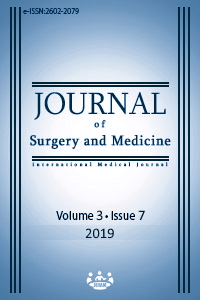Prevalence of influenza vaccination among health care workers and adverse effects after vaccination: A cross-sectional study
Keywords:
Health care workers, Influenza vaccine, Advers eventAbstract
Aim: Influenza is an important public health problem for the whole world and the prevalence of influenza vaccination is low.The aim was to determine the prevalence of influenza vaccination and adverse effect after seasonal influenza and/or pandemic A (H1N1) influenza vaccination in health care workers (HCW) working in Ankara.
Methods: It is a cross-sectional study. In March-April 2010, 1611 HCW from Atatürk Hospital, Sami Ulus Hospital and 13 Primary Health Care centers have been reached and survey was conducted.
Results: 41.1% of HCW have had seasonal influenza vaccination and 26.1% of them had side effects. Most of HCW, who have not been vaccinated; reported the needlessness of vaccination and fear of side effect as explanation of reason for being not vaccinated. 46.6% of examined HCW had pandemic influenza vaccination. After pandemic influenza vaccination, any of side effect was seen in 66.4% of vaccinated HCW. Most of HCW, reported the needlessness of vaccination, fear of side effect, inability to vaccinate, debates and contradictions on the views, as explanation of reason for being not vaccinated.
Conclusion: As a result, vaccination percents are under expected. HCW, like every part of public, are affected from actual discussions. For health services being not affected from these conditions, HCW’s knowledge should be renewed and updated.
Downloads
References
Evans AS. Viral infections of humans. Epidemiology and control. Second Edition. Plenium Medical Book Company. London 1990;397-18.
Beker CM, Ceylan S, Dizer U, Güleç M, Özgüven V, Pahsa A. İnfluenza aşısı uygulamasının üst solunum yolu infeksiyon sıklığı, işgücü ve maliyet üzerine etkisi. Türk Hij Den Biyol Derg. 2003;60(2):33-8.
Vasoo S, Stevens J, Singh K. Rapid antigen tests for diagnosis of pandemic (Swine) influenza A/H1N1. Clin Infect Dis. 2009;49(7):1090–3.
Kyaw MH, Wayne B, Chalmers J, Jones IG, Campbell H. Influenza and pneumococcal vaccine distribution and use in primary care and hospital settings in Scotland: coverage, practice and policies. Epidemiol Infect. 2002;128:445-55.
Hacımustafaoğlu M. Pandemik 2009 H1N1 influenza enfeksiyonları. Türk Ped Derg. 2010;45-80.
Aksakoğlu G. Bulaşıcı hastalıkla savaşım, DEÜ Yayını, Üçüncü basım, İzmir, 2008.
Global surveillence during on infection. Pandemic/WHO/Version 1 April 2009.
Schnitzler SU, Schnitzler P. An update on swine-origin influenza virus A/H1N1: a review. Virus Genes. 2009;39(3):279-92.
Jeeninga RE, Jong M, Berkhout B. The new influenza A (H1N1) pandemic. J Formos Med Assoc. 2009;108:523-5.
Christophe F, Christl AD. Pandemic potancial of a strain of influenza A(H1N1):early findings. Science. 2009;374:1557.
Bodewes R, Kreijtz J, Rimmelzwaan GF. Yearly influenza vaccinations: a double-edged sword. Lancet Infect Dis. 2009;9:784-8.
2009 influenza pandemic. http://www.fas.org/sgp/crs/misc/R40560.pdf
Aktaş F. H1N1 aşısı: yapılsın mı? yapılmasın mı? ANKEM Derg. 2010;24:201-5.
Chliberk R, Anca I, Andre F, Bakir M, Ivaskeviciene I, Mangarov A, et al. Central european vaccination advisory group (CEVAG) guidance statement on recommendations for 2009 pandemic influenza A (H1N1) vaccination. Vaccine. 2010;10405:1-9.
Raude J, Setbon M. Lay perceptions of the pandemic influenza threat. Eur J Epidemiol. 2009;24:339-42.
Zhu F, Wang H. A novel influenza A (H1N1) vaccine in various age groups. The New England Jounal of Medicine. 2009;10:361.
Eskiocak M, Özyurt A. TTB pandemik influenza a h1n1v bilimsel danışma ve izleme kurulu pandemik çalışma raporu. Türk Tabibler Birliği Yayını, 2010.
Valdespino-Gomez JL, Garcia L, Leon-Rosales SP. Vaccines against influenza A (H1N1) pandemic. Archives of Med Research. 2009;40:693-704.
Kilbourne ED. Influenza pandemics of the 20th century. Emerg Infect Dis. 2006;12:9-14.
CDC. Safety of influenza A (H1N1) 2009 monovalent vaccines. MMWR. 2009;58:1.
Opstelten W, Essen GA, Heijnen ML, Ballieux M, Goudswaard AN. High vaccination rates for seasonal and pandemic (A/H1N1) influenza among healthcare workers in Dutch general practice. Vaccine. 2010;28:6164-8.
Murray SB, Skull SA. Poor health care worker vaccination coverage and knowledge of vaccination recommendations in a tertiary Australia hospital. Aust NZJ Public Health. 2002;26:65-8.
Ulusoy E, Arıkan D. Çocuk ünitesinde çalışan sağlık bakım personelinin grip aşısı oranları. Turkiye Klinikleri J Nurs. 2010;2(1):11-5.
İlhan MN, Aksakal FN, Şenlik ZB, Dikmen AU, Ceyhan MN, Durukan E, et al. Bir üniversite hastanesinde görev yapan araştırma görevlisi doktor intern doktor ve hemşirelerin influenza aşısı olma durumları. 11. Ulusal Halk Sağlığı Kongresi, Denizli; Ekim 2007.
Thoon KC, Chong CY. Survey of healthcare workers’ attitudes, beliefs and willingness to receive the 2009 pandemic influenza A (H1N1) vaccine and the impact of educational campaigns. Ann Acad Med Singapore. 2010;39(4):307-6.
Kaboli F, Astrakianakis G, Li G, Guzman J, Naus M, Donovan T. Influenza vaccination and intention to receive the pandemic H1N1 influenza vaccine among healthcare workers of British Columbia, Canada: a cross-sectional study. Infect Control Hosp Epidemiol. 2010;8:13.
Schwarzinger M, Verger P, Guerville MA, Aubry C, Rolland S, Obadia Y, Moatti JP. Positive attitudes of French general practitioners towards A/H1N1 influenza-pandemic vaccination: a missed opportunity to increase vaccination uptakes in the general public? Vaccine. 2010 Mar 24;28(15):2743-8.
Parlakay AÖ, Ceyhan M. Pandemik influenza aşısı. Hacettepe Tıp Dergisi. 2010;41:58-61.
Greenberg ME, Lai MH, Hartel GF. Response after one dose of a monovalent Influenza A (H1N1) 2009 vaccine. N Engl J Med. 2009;361:2405-13.
Black S, Eskola J, Siegrist CA, Halsey N, Macdonald N, Law B, et al. Importance of background rates of disease in assessment of vaccine safety during mass immunisation with pandemic H1N1 influenza vaccines. Lancet. 2009;19(374):2115-22.
Downloads
- 1532 2223
Published
Issue
Section
How to Cite
License
Copyright (c) 2019 Asiye Uğraş Dikmen, Fatma Nur Baran Aksakal, Zehra Aycan, Sefer Aycan
This work is licensed under a Creative Commons Attribution-NonCommercial-NoDerivatives 4.0 International License.
















